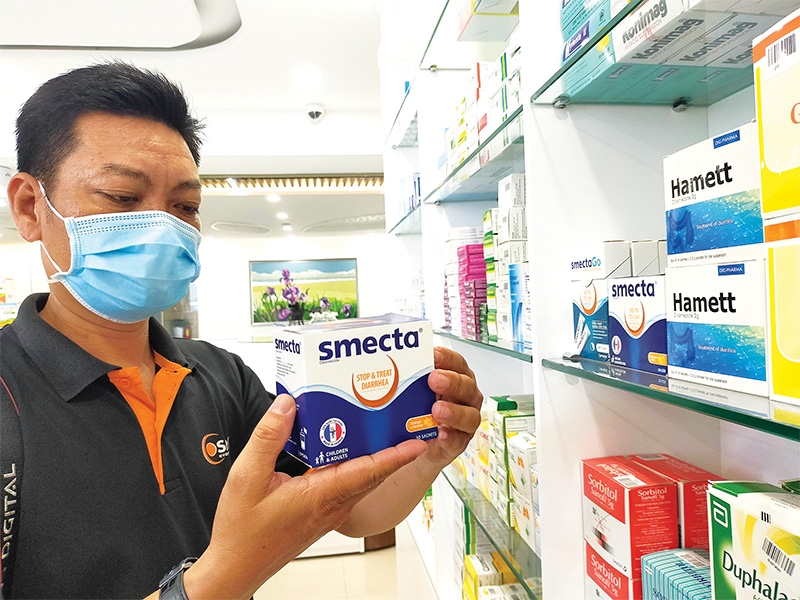New circular unsettles pharmaceutical giants
 |
| Ethical drugs are the main distribution channel in the local pharma market, accounting for around 70 per cent, Photo Le Toan |
The Ministry of Health’s (MoH) Drug Administration of Vietnam (DAV) on August 10 issued Circular No.15/2020/TT-BYT on the list of drugs for procurement through bidding, the list of drugs for concentrated procurement, and the list of drugs for procurement through price negotiation, with some changes aiming to lower prices of brand-name drugs.
An official at the DAV said that with the new rules, most branded drugs will be added to the third list for procurement through price negotiation.
“In the past, just eight brand-name drugs were on the list, but now the number will increase to 700,” he told VIR.
Under Circular 15, pharmaceuticals subject to price negotiation include brand-name drugs announced by the MoH, and wholly produced in a country considered a stringent regulatory authority (SRA).
They must have at least two registration certificates of marketing authorisation of generic Group 1 drugs.
As per the new rules, there are two schemes for procurement of branded items: price negotiation, and open bidding in Group 1 of generic pharmaceuticals under Circular No.15/2019/TT-BYT dated July 2019 regulating drug tenders at public healthcare facilities.
Specifically, brand-name pharmaceuticals with many generic drugs in replacement in Group 1 failing in procurement via price negotiation will be included in tender of that group.
The new issuance amending some regulations on tenders in Circular 15 of 2019 is in line with the government’s direction to increase local access to quality medicines and to reduce prices, focusing on brand-name drugs.
Previously in Circular 15, branded drugs or equivalents were named in the specific tender. In-patient and off-patient pharmaceuticals (OPPs) are not classified as different by the MoH and are still included in tenders for brand-name drugs or equivalent drugs with costs 10-20 times higher than generic products.
Meanwhile, tenders of generic drugs are divided into five groups, with Group 1 including drugs manufactured entirely by a manufacturing line satisfying EU-GMP requirements or equivalent requirements in a country that is considered an SRA.
Taking effect from October 6 and replacing Circular No.09/2016/TT-BYT from 2016, the new rule is not good news for multinational corporations (MNCs) and members of the European Chamber of Commerce in Vietnam’s Pharma Group such as Novartis, AstraZeneca, and GSK advocate price negotiation.
With the new issuance, they may have to reduce prices to compete with other generic Group 1 drugs, meaning that their future profits may be reduced.
Industry insiders said that the big blow may hit MNCs which focus on OPPs, with many generic drugs in replacement in Group 1. They are mostly from Eastern Europe and Asia.
According to statistics from the DAV, brand-name drugs make up an average of 26 per cent of total health insurance spending. The rate is 47 per cent at central hospitals and 26 per cent at provincial ones.
MNCs often rake in big profits because their brand-name pharmaceuticals go to the hospital system or the ethical drugs channel (ETC), the most profitable segment.
At present, the ETC is the main distribution channel in the local pharma market, accounting for around 70 per cent, while the remainder of the market comprises of over-the-counter or non-description drugs. Foreign players hold the majority of the ETC market due to ownership of brand-name drugs, which operate in a monopolistic manner and usually sell at high prices.
What the stars mean:
★ Poor ★ ★ Promising ★★★ Good ★★★★ Very good ★★★★★ Exceptional
Themes: COVID-19
- 67 million children missed out on vaccines because of Covid: UNICEF
- Vietnam records 305 COVID-19 cases on October 30
- 671 new COVID-19 cases recorded on October 1
- Vietnam logs additional 2,287 COVID-19 cases on Sept. 21
- People’s support decisive to vaccination coverage expansion: official
Related Contents
Latest News
More News
- Businesses ramp up production as year-end orders surge (December 30, 2025 | 10:05)
- Vietjet chairwoman awarded Labour Hero title (December 29, 2025 | 13:06)
- How to unlock ESG value through green innovation (December 29, 2025 | 10:03)
- AI reshapes media and advertising industry (December 29, 2025 | 08:33)
- FPT and GELEX sign deal to develop blockchain tech for global markets (December 29, 2025 | 08:29)
- Vietnam’s GDP forecast to grow by 9 per cent in 2026 (December 29, 2025 | 08:29)
- Women entrepreneurs are key to Vietnam’s economic growth (December 29, 2025 | 08:00)
- Vietnam's top 500 value-creating enterprises announced (December 27, 2025 | 08:00)
- The PAN Group shaping a better future with ESG strategy (December 26, 2025 | 09:00)
- Masan Consumer officially lists on HSX, marking the next phase of value creation (December 25, 2025 | 13:20)

 Tag:
Tag:




















 Mobile Version
Mobile Version